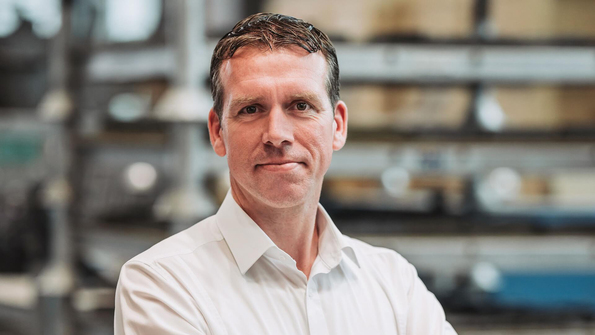-
Software
-
CAM software
- Tebis Automill
- CNC programming
- CNC automation
- CNC simulator
- Multiple setup
- Robotic machining
- CNC drilling
- Deep-hole drilling
- Combined turn-milling
- CNC turning
- Turn-milling
- 2.5D milling
- 3D milling
- 5-axis milling
- Slot milling
- Trimming
- HPC milling
- HFC milling
- Circle-segment cutters
- Sinker EDM
- Wire EDM
- 3D laser cutting
- Laser hardening
- Laser weld cladding
- CAD software
- CAQ software
- MES software
- Products
- Stories about parts
-
CAM software
- Services
- Consulting
- Sectors
- References
- Company
- News

-
 Home References
Home ReferencesWith Tebis 4.1, Grunewald relies on standards that evolve with practice
Since its founding in 1963, the family-owned company Grunewald has stood for innovation and maximum quality in die and mold manufacturing, special machine manufacturing, as well as light metal casting technology.
Once it got its first CNC machine, Grunewald soon adopted Tebis. Since then, Tebis has been its programming system of choice. It now uses Tebis Version 4.1 for 5-axis milling and, in some cases, for the design process too.Company
Grunewald GmbH & Co. KG
Location
Bocholt, Germany
Focus
Special machine manufacturing, light metal casting technology
Benefits:
- Automated programming of routine tasks in Tebis 4.1 using features and templates
- Tebis modules (like 5-axis milling) ensure high precision and productivity
- Libraries (tools, clamping devices) enable automated programming
- Safe, reliable machining using a digital twin/virtual machine
Sector
Die manufacturing
Mold manufacturing
Published
2025

Interviewee: Jörg Engler, Head of Mechanical Manufacturing at Grunewald
With the experts at Tebis, we have partners at our side who share our high quality standards and can draw on their extensive experience to help us advance and offer our customers even better, faster, and more precise manufacturing in the future.
Jörg Engler, Head of Mechanical Manufacturing at GrunewaldGrunewald GmbH & Co. KGStandards are the backbone of digitalization and automation. A high level of automation crucially requires standards and libraries. Grunewald, based in Bocholt, Germany, has a systemic approach for keeping them up to date—even when there are many different parts, many of which require special solutions.
Since it was established in 1963, family-owned Grunewald has stood for innovation and maximum quality in die and mold manufacturing, special machine manufacturing, as well as light metal casting technology. About 220 employees at the Bocholt and Irxleben sites continue to shape the future of production by pushing technological boundaries and establishing efficient processes for the long term. At Grunewald, tradition and progress go hand in hand, providing the basis for exceptional products and solutions.
Its die manufacturing department produces models for low-pressure sand casting as well as steel and aluminum molds. Its products and services also include RTM molding and comprehensive expertise in systems engineering for special machines suitable for manufacturing, for example. Its customers come from various sectors, including the automotive and semiconductor industries, medical technology, and especially the aerospace industry.Efficient and high-precision manufacturing, even for large molds
Grunewald possesses an array of high-performance, state-of-the-art machinery. In addition to many other machining centers, its mold and die experts have access to an Emco Mecof “Mecmill” traveling-column milling machine that was commissioned in 2022. They also have several other machines that can handle a wide range of machining operations.
As a partner to the aerospace and automotive industries, the experts at Grunewald are able to efficiently and precisely manufacture even large molds up to 14 m long, 1,600 mm wide, and 3,600 mm tall (or, with custom setups, even larger dimensions)—for example, to produce tools for manufacturing large composite parts.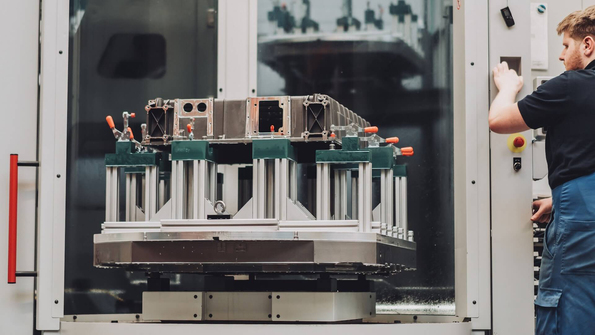 Many parts require complex clamping devices and fixtures; Tebis records this equipment data in a library, complete with all the relevant details, to enable valid, realistic simulations. – Photo: Grunewald
Many parts require complex clamping devices and fixtures; Tebis records this equipment data in a library, complete with all the relevant details, to enable valid, realistic simulations. – Photo: Grunewald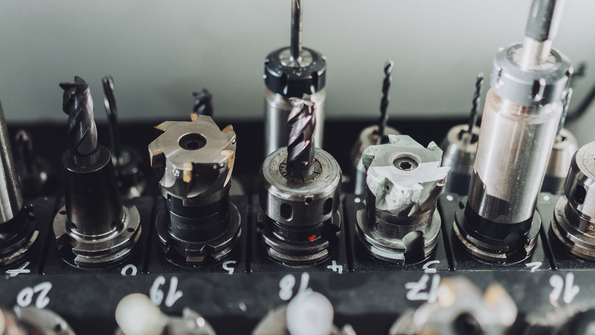 Tebis libraries document all the tools in detail—including their geometric data as well as different parameter sets for different materials and application scenarios. – Photo: Grunewald
Tebis libraries document all the tools in detail—including their geometric data as well as different parameter sets for different materials and application scenarios. – Photo: GrunewaldDedicated Tebis users
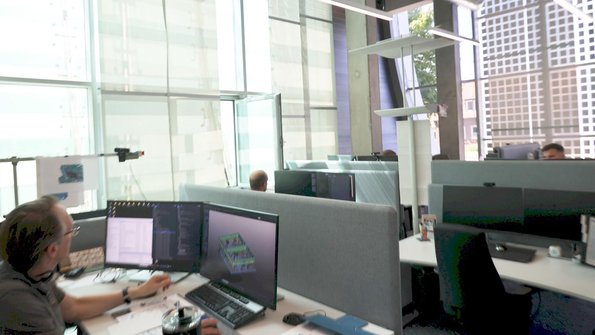 Experienced programmers are responsible for determining whether data from the manufacturing process is also applicable to future machining and should be translated into a standard format, taking advantage of the experience and knowledge of employees who actually work with the machines to continuously improve processes. – Photo: Pergler Media
Experienced programmers are responsible for determining whether data from the manufacturing process is also applicable to future machining and should be translated into a standard format, taking advantage of the experience and knowledge of employees who actually work with the machines to continuously improve processes. – Photo: Pergler MediaGrunewald has been designing in 3D since 1985. Jörg Engler, Head of Mechanical Manufacturing at Grunewald in Bocholt, explained: “We got our first 5-axis CNC machine back in 1987."
At first, Grunewald used a programming system from Switzerland, but we weren’t really satisfied. Before long, we switched to Tebis, mainly because of its 5-axis milling features, and we’ve stuck with it ever since, recently upgrading to the latest Version 4.1.
The mold specialists also do some of their design work in Tebis, especially the CAD models for low-pressure sand casting, which are created digitally in a 3D printing process. But above all, Tebis is their programming system of choice, used to provide programs for about 20 milling machines. Wire EDM also runs entirely in Tebis.
Increasing integration of more turning
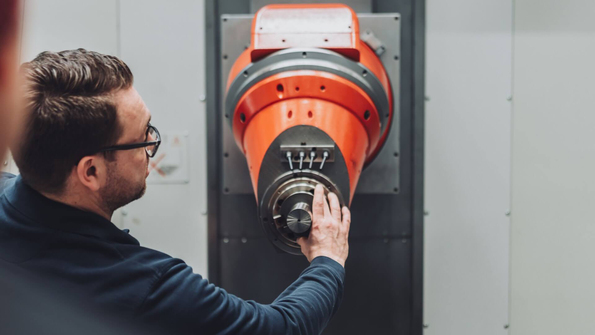 Without systematic use of a channel for obtaining feedback from manufacturing for programming, a lot of knowledge can simply get lost. At Grunewald, insights from the workshop are consistently passed back to the programmers, helping constantly raise the standard. – Photo: Grunewald
Without systematic use of a channel for obtaining feedback from manufacturing for programming, a lot of knowledge can simply get lost. At Grunewald, insights from the workshop are consistently passed back to the programmers, helping constantly raise the standard. – Photo: GrunewaldEngler admitted: “The only thing we don’t yet do with Tebis is turning—we still usually program that operation right on the machine.”
But we’re working with Tebis experts to integrate these operations into our CAM programming, too.
At this point, only a very small percentage of the programming is done on the machine, and the goal is to reduce that further and, if possible, even eliminate it entirely. The manufacturing manager explained: “It mostly involves the simplest bore patterns in base plates and similar components—minor stuff, most of which is currently handled in our training workshop.”
Standards as the backbone of automation
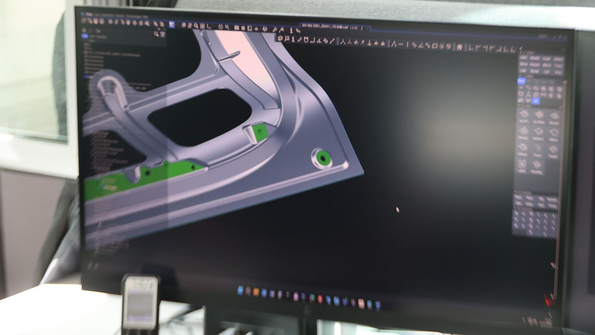 Once it got its first CNC machine, Grunewald soon adopted Tebis, and they were impressed by this software developer from Martinsried, Germany right from the start. With its new Version 4.1, Tebis has established itself as a key pillar of production. – Photo: Pergler Media
Once it got its first CNC machine, Grunewald soon adopted Tebis, and they were impressed by this software developer from Martinsried, Germany right from the start. With its new Version 4.1, Tebis has established itself as a key pillar of production. – Photo: Pergler MediaStandards are the backbone of automation and provide the basis for efficient programming with Tebis. Grunewald already created extensive tool libraries for Tebis Version 4.0. Engler described the company's approach: “These libraries contain all the tools we use, complete with their geometry data and the associated machining parameters for the different materials we work with.”
That way, we can make good use of the programming automation functions in Tebis, and the programmers have time to focus on what’s important: the best possible machining for the mold or part.
With the shift to Version 4.1, Tebis has created many such powerful options to permanently increase the efficiency and quality of the programming. However, migrating to the new version also requires a new workflow, so Grunewald had to do some prep work first.
Migration definitely requires some work
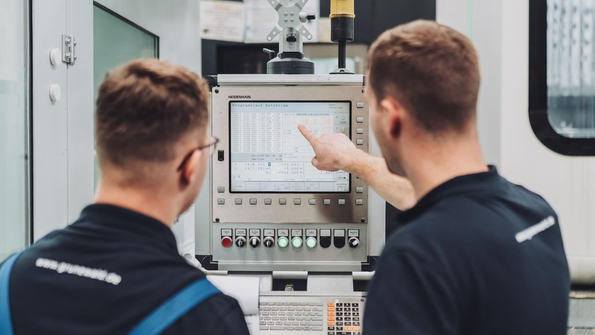 Two key users at Grunewald ensure a smooth migration to Tebis 4.1. In many workshops, they familiarized themselves with the new version’s functions and then helped train everyone else who would use the software. – Photo: Grunewald
Two key users at Grunewald ensure a smooth migration to Tebis 4.1. In many workshops, they familiarized themselves with the new version’s functions and then helped train everyone else who would use the software. – Photo: GrunewaldThe manufacturing expert recalled:
We brought in two key users and had Tebis experts thoroughly train them first.
“We held a number of workshops—first here in Bocholt, then in Irxleben—for users to familiarize themselves with the new version’s functions and structures, starting with those two key users and then, with their support, training everyone else who would use the software.”
This is all a very complex process, which involves reviewing workflows and adapting them as needed. This entailed quite a bit of homework between workshops and a lot of effort from everyone involved. Libraries from the previous Tebis version were revised again. Most of the tool data comes from the tool presets, taken directly from a Gühring tool management system. Data for the clamping devices was also carefully recorded and digitalized.A precise digital representation of reality
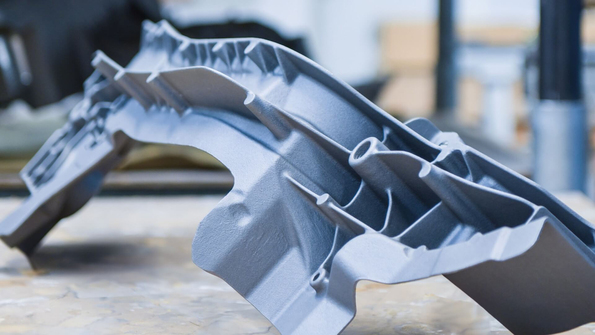 Grunewald primarily handles highly complex, demanding parts, and it does not always make sense to classify these parts into part classes and process them in a fully standardized way. Tebis 4.1 provides the necessary freedom for highly flexible programming. – Photo: Grunewald
Grunewald primarily handles highly complex, demanding parts, and it does not always make sense to classify these parts into part classes and process them in a fully standardized way. Tebis 4.1 provides the necessary freedom for highly flexible programming. – Photo: GrunewaldThe machine geometries and operating parameters are also available in digital form. Since the digital 3D data set supplied by the manufacturer does not reflect the reality precisely enough, all the 5-axis machines were measured by Tebis specialists.
This ensures that the simulation, which all the programs run before they are used on the machine, actually reflects reality precisely, and that, when the software says “collision-free”, this truly guarantees risk-free machining.
All together, these preparations took a good nine months.
The standardization required for automating the machining processes was a real challenge for Grunewald. Engler explained: “It’s difficult because of the enormous variety of parts we handle. The geometries are normally very complex and demanding. We consider it best practice to classify our parts and define the processing steps in templates, so we do this whenever it’s possible and makes sense. Our standards and automation capabilities enable us to make the best possible use of our valuable resources, especially our programming capacities.”Testing the limits of sensible automation
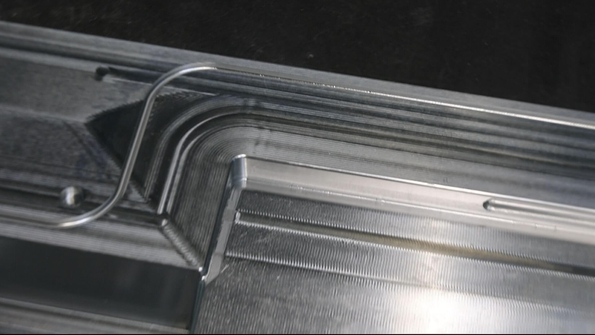 Grunewald’s customers come from various sectors, including the automotive and semiconductor industries, medical technology, and, increasingly, the aerospace industry. – Photo: Pergler MediaThe experienced production expert reported:
Grunewald’s customers come from various sectors, including the automotive and semiconductor industries, medical technology, and, increasingly, the aerospace industry. – Photo: Pergler MediaThe experienced production expert reported:However, the limits of this approach often become clear as the demands on part geometries increase.
For example, pockets in molds and casting models are getting deeper and deeper and are often so narrow that we have to use special tools. Or customers insist on bores in parts in increments of tenths of a millimeter.
“Clearly, we work with highly complex, demanding parts, and it doesn’t always make sense to classify these parts into part classes. You also run up against the limits of working with standards and templates. There’s nothing to be gained by trying to force automation further in these cases, since it just doesn’t pay off at that point.”
Defining standards depends heavily on the machinery, processes, strategies, and many other factors that are very company-specific. Engler noted: “And it requires in-depth knowledge of both processes and the specific conditions in the company. That’s why it wouldn’t work to force a default scheme onto the company. Every company has to do this work for itself.”Optimized data provides feedback to the standards
 The mold specialists in Bocholt also do some of their design work in Tebis, especially the CAD models for low-pressure sand casting, for which Grunewald uses a digital 3D printing process, among other techniques. – Photo: Grunewald
The mold specialists in Bocholt also do some of their design work in Tebis, especially the CAD models for low-pressure sand casting, for which Grunewald uses a digital 3D printing process, among other techniques. – Photo: GrunewaldWhere their use makes sense, standards ensure that processes are optimized and run smoothly. Engler emphasized: “But our standards aren’t set in stone either.”
As always, the best is the enemy of the good. For example, if there are parameters that still need to be optimized on a machine, or an employee is working with a new type of material or tool, the data is immediately passed back to the programming process, where it can be incorporated into the standards. That way, we have a system that evolves with practice, where the libraries and machining templates always stay up to date.
At Grunewald, Evomecs MES is used for communication between the machines and the Tebis software and also passes the optimized data from the machine back to the Tebis libraries. The machining experts use this cloud-based app system to control and monitor their production, automatically record operating data, and track parts seamlessly. As Engler explained: “We start our machines via Evomecs, and Evomecs is also used for feedback from machine operators to CAM programmers.”
Individualized user support
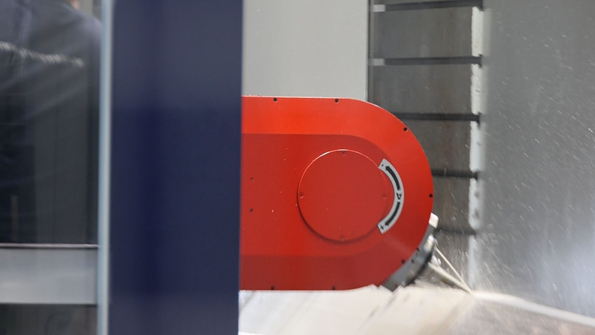 The Emco Mecof “Mecmill” traveling-column milling machine, which was commissioned in 2022, enables even large molds of up to 14 m long, 1,600 mm wide, and 3,600 mm tall to be manufactured efficiently and precisely—for example, for producing large composite parts. – Photo: Pergler MediaThe manufacturing manager described one of the challenges:
The Emco Mecof “Mecmill” traveling-column milling machine, which was commissioned in 2022, enables even large molds of up to 14 m long, 1,600 mm wide, and 3,600 mm tall to be manufactured efficiently and precisely—for example, for producing large composite parts. – Photo: Pergler MediaThe manufacturing manager described one of the challenges:The company needs a very diverse collection of cutting-edge machinery to handle a wide range of capabilities.
It’s not always possible to process a given part on the best possible machine—for example, because it’s already being used elsewhere.
And not every machine can run at, say, 18,000 rpm, which might be optimal for a specific machining operation. In these cases, seamless interaction between Tebis and Evomecs and the high quality of our postprocessors give us a great deal of flexibility, so we can switch between machines without difficulty—and the machine operators also seamlessly pass their new insights on to the programmers.”
Throughout all the changes, the Grunewald employees handling the migration have always been able to rely on comprehensive support from Tebis experts. Engler added: “Still, anyone making a switch like this needs to anticipate an initial decline in manufacturing output. For us, this phase lasted a few weeks; by then, everything had sorted itself out.”In-depth training unlocks huge added value
 Each tool at Grunewald is clearly identified with a QR code. The programmers try to rely on the existing standard tools as much as possible, but complex geometries often require special tools. – Photo: Pergler MediaThe Head of Mechanical Manufacturing recalled the training experience:
Each tool at Grunewald is clearly identified with a QR code. The programmers try to rely on the existing standard tools as much as possible, but complex geometries often require special tools. – Photo: Pergler MediaThe Head of Mechanical Manufacturing recalled the training experience:Although we got ‘standard’ Tebis 4.1 training, our partners also went into great detail about our options and, in particular, our part portfolio.
“Our intensive training is paying off; with Version 4.1, Tebis offers huge added value.”
But if you want to make the most of this added value, you need to know what you’re doing and what else can be done. Engler noted: “Let’s be honest: when you use a piece of software, you mostly rely on only the functions you’re familiar with. If you really want to take full advantage of the possibilities, you need training, or you’ll be learning the hard way.”Valuable know-how gained
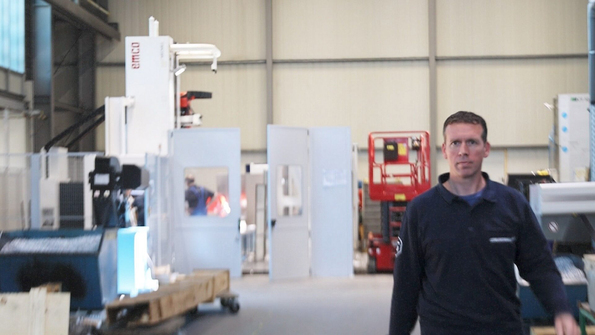 Grunewald possesses a diverse range of state-of-the-art high-performance machinery, enabling the company to handle a wide range of machining tasks and parts from many different industries. – Photo: Pergler Media
Grunewald possesses a diverse range of state-of-the-art high-performance machinery, enabling the company to handle a wide range of machining tasks and parts from many different industries. – Photo: Pergler MediaWith Tebis 4.1, the company got more than just a new software version—the training sessions, most of which were structured as in-house workshops, also allowed employees to gain quite a bit of process and machining know-how. Engler emphasized: “We hold ourselves to very high quality standards.
And with the Tebis experts, we have partners at our side who share this commitment to quality and can draw on their extensive experience to help us advance and offer our customers even better, faster, and more precise manufacturing in the future.
Profile
Grunewald GmbH & Co. KG
Grunewald uses state-of-the-art low-pressure sand casting technology and 5-axis machining centers to manufacture close-to-production individual and series products from aluminum and iron alloys. The flexible production capabilities at the Bocholt and Irxleben sites allow for machining parts up to 14 m long. Precise measurement and qualification of parts on site ensure maximum accuracy. A CAD department with 17 experts, directly integrated into manufacturing operations, optimizes throughput times and ensures maximum efficiency. All steps, from CAD design and model manufacturing to finishing, are performed in Bocholt under one roof, guaranteeing short manufacturing routes and efficient manufacturing.Focus
Making sure a digital twin actually reflects reality
For virtual machines, Tebis individually records all the relevant machine data at the user’s location. Tebis specialists record and measure all movements in the machine space and all actual geometries. The geometries of tool heads, spindles, cooling nozzles, laser equipment, and units can vary, even in machines of the same type. Therefore, the machine data is recorded individually with all possible collision elements and reference points. The virtual machine stores the machine logic in full, allowing maximum use of the entire machining space. Furthermore, the actual manufacturing process can be fully simulated and controlled in the virtual CAD/CAM environment before NC output, saving time and enabling the user to reliably prevent collisions.Perspectives
Evolving standards for optimal manufacturing conditions
At first glance, “standards” sounds like a very static concept—something you establish once and then never touch again. Otherwise, what would be the point of having standards, right? Well, it’s not quite that simple, because small changes often have big impacts, such as: a new tool, a new material, a change in the type of cooling lubricant, among many other examples. In cases like these, companies benefit greatly from having a standardized (!) mechanism for gaining new insights “from the cutting edge” to be passed directly back to the programming process. Then experienced programmers can decide: should these insights be incorporated into the standard, or do they only pertain to an individual case that should be handled separately? The most important thing is for such a feedback channel to exist, since it is the only way to ensure that valuable—and often hard-earned—machining know-how can be leveraged to improve a company’s capabilities and processes and help make it more competitive in the long term.Richard Pergler
